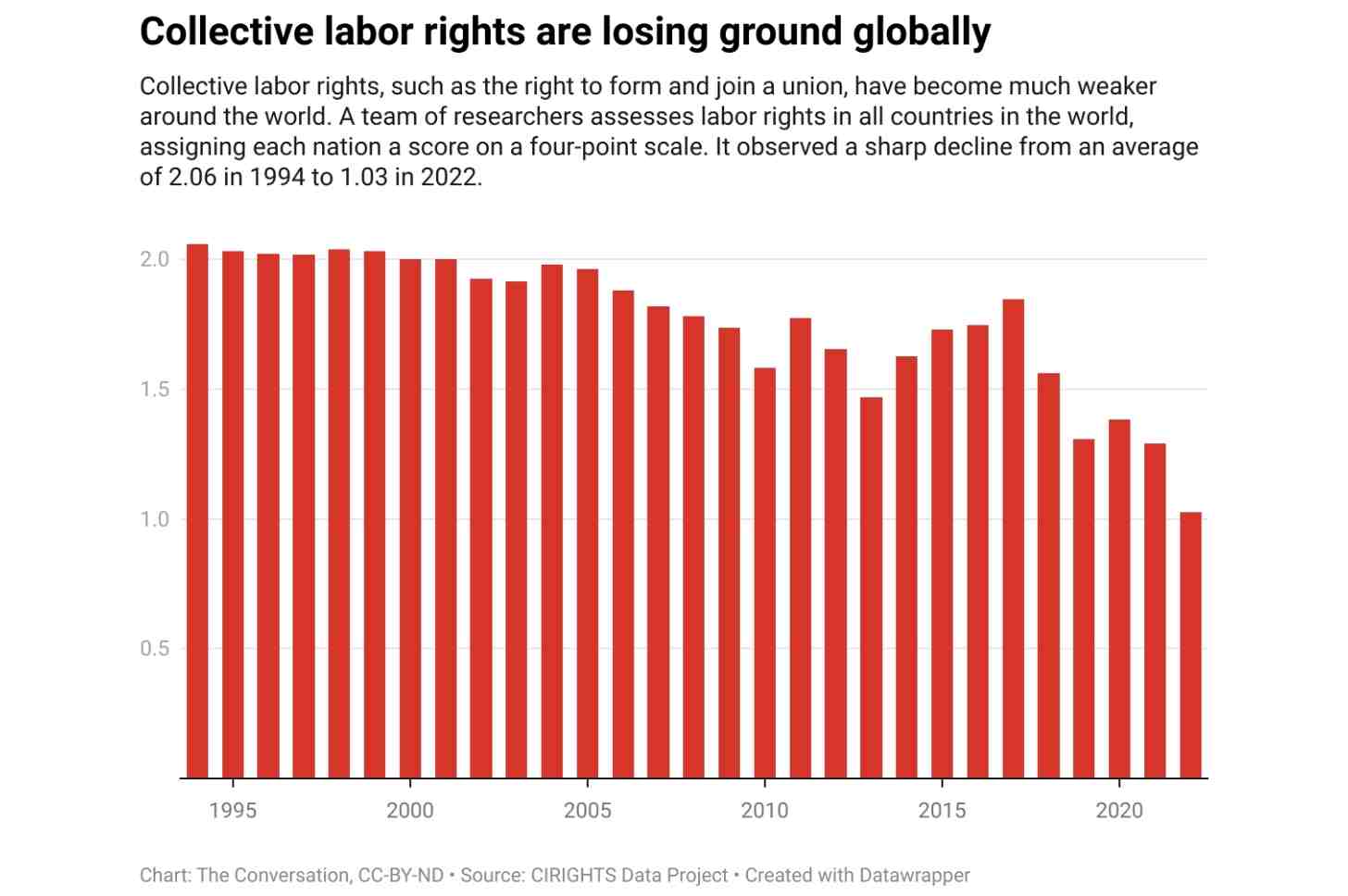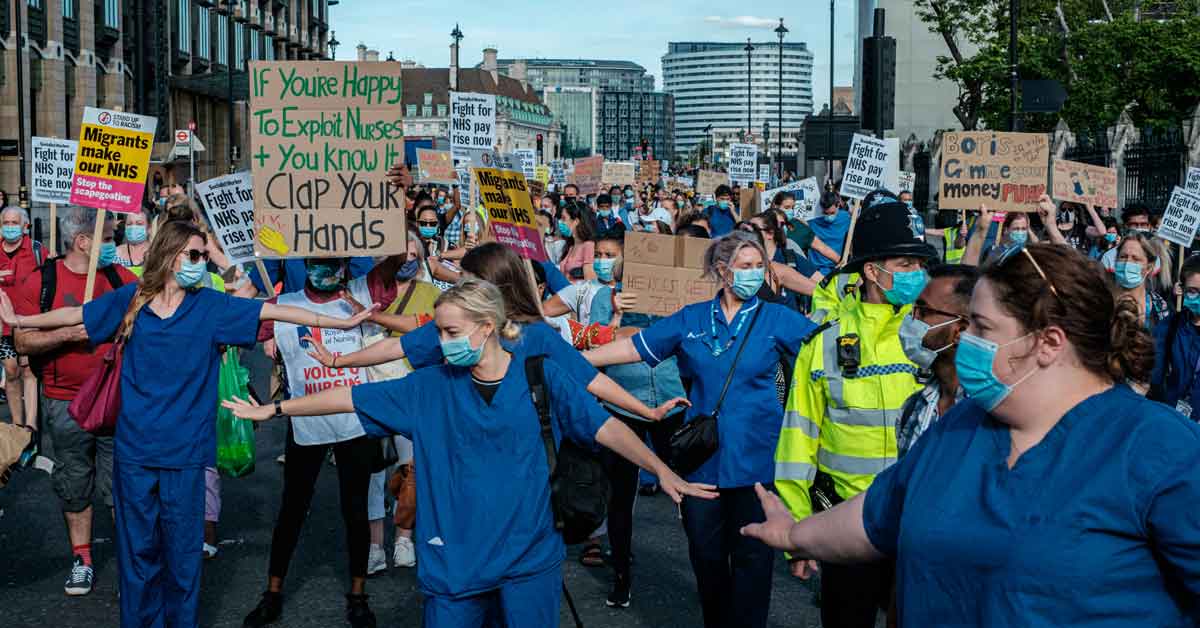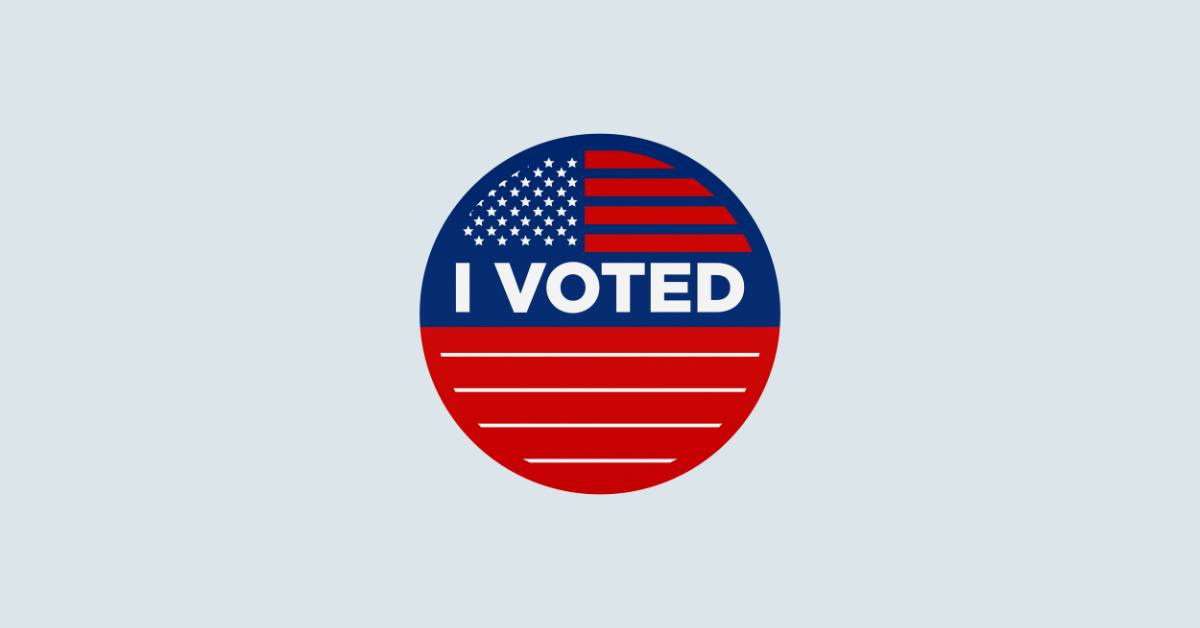Despite the strength of the U.S. economy, the gap between rich and poor Americans is increasing.
The wealthiest 1% of Americans have more than five times as much wealth as the bottom 50%, according to the U.S. Federal Reserve. That’s up from four times as much in the year 2000. In 2024 alone, the wealthiest 19 families got a total of US$1 trillion richer — the largest one-year increase on record.
And yet 59% of Americans don’t have enough money saved up to cover an unexpected $1,000 expense.
We are political scientists who study human rights and political economy.
In a 2023 study, our team looked at 145 countries, including the U.S., to understand the link between labor rights and inequality. We found evidence that strengthening collective labor rights may reduce economic inequality.
Empowering workers
Collective labor rights include the rights to form and join a union, bargain collectively for higher pay and better working conditions, go on strike, and get justice if employers punish workers who exercise these rights.
In the U.S., where less than 10% of workers belong to unions, union members typically earn higher wages than their nonunion counterparts.
Through negotiations on behalf of their members, unions can pressure employers to provide fair wages and benefits. If negotiations break down, the union can call for a strike — sometimes winning better benefits and higher wages as a result.
Some U.S. unions don’t have the right to strike, including air traffic controllers, teachers, and those working on national security issues. But most unions have some ability to implement work stoppages and impose costs on employers to negotiate for raises, better benefits, and conditions.
Reducing inequality
For our study, we analyzed the human rights in the CIRIGHTS dataset, which uses human rights reports from the U.S. State Department, Amnesty International and other sources to measure government respect for 24 human rights, including the rights to unionize and bargain collectively.
The dataset is produced by the University of Rhode Island, Binghamton University, and the University of Connecticut. One of us, Skip Mark, serves as a co-director of the project.
Using a scoring guide, a team of researchers reads human rights reports and gives each country a score of zero if they have widespread violations, one point if they have some violations, or two if they have no evidence of violations. The team has assigned scores for all 24 rights from 1994 through 2022.
Using this data, we created a measure of collective labor rights by adding scores for the right to workplace association and the right to collective bargaining. The resulting collective labor rights score ranges from zero to four.
Countries where workers’ rights are routinely violated, such as Afghanistan, China, and Saudi Arabia, scored a zero.
The United States, Macedonia, and Zambia, three countries with little in common, were among those that tended to get two points, placing them in the middle.
Countries with no reported violations of the rights to workplace association and collective bargaining, including Canada, Sweden, and France, got four points.
According to the CIRIGHTS dataset, the strength of respect for collective labor rights around the world declined by 50%, from 2.06 in 1994 to 1.03 in 2022.

At the same time, according to the World Inequality Dataset, the share of income earned by the 1% with the biggest paychecks increased by 11%.
We used advanced statistical methods to figure out whether better worker protections actually reduce inequality or are just associated with it.

Gaps between individuals and ethnic groups
We also measured what’s been happening to economic inequality, using two common ways to track it.
One of them is vertical inequality, the gap between what people earn within a country — the rich versus the poor. The more unequal a society becomes, the higher its vertical inequality score gets.
We measured it using the disposable income measure from the Gini index, a commonly used indicator of economic inequality that captures how much money individuals have to spend after taxes and government transfers.
We found that a one-point increase in collective labor rights on our four-point scale reduces vertical inequality by 10 times the average change in inequality.
For the U.S., a one-point increase in collective labor rights would be about enough to undo the increase in inequality that occurred between 2008 and 2010 due to the Great Recession and its aftermath. It would also likely help stem the growing wealth gap between Black and white Americans. That’s because income disparities compound over time to create wealth gaps.
We also assessed the connection between horizontal inequality, which measures income inequality between ethnic or other groups, and collective labor rights.
Negative horizontal inequality measures the amount of a country’s income held by the poorest ethnic group. Higher scores for this metric indicate that the lowest-earning ethnic group has less income relative to the rest of society. Black Americans have the lowest median income of any racial or ethnic group, according to the U.S. Census Bureau.
Positive horizontal inequality measures the income earned by the richest ethnic group. When positive horizontal inequality rises, that means the richest ethnic group has more income relative to the rest of society. According to the same Census Bureau report, Asian Americans had the highest median earnings.
We found that stronger collective labor rights, both in law and in practice around the world, also reduce both types of horizontal inequality.
This means they raise the floor by helping to improve the income of the poorest ethnic groups in society. They also close the gap by limiting the incomes of the richest ethnic group, which can reduce the likelihood of conflicts.
That is, our findings suggest that when workers are free to advocate for higher wages and better benefits for themselves, it also benefits society as a whole.
This article was originally written by Skip Mark from the University of Rhode Island and Stephen Bagwell from University of Missouri-St. Louis, and was published on The Conversation.
Header Image by Ehimetalor Akhere Unuabona on Unsplash



